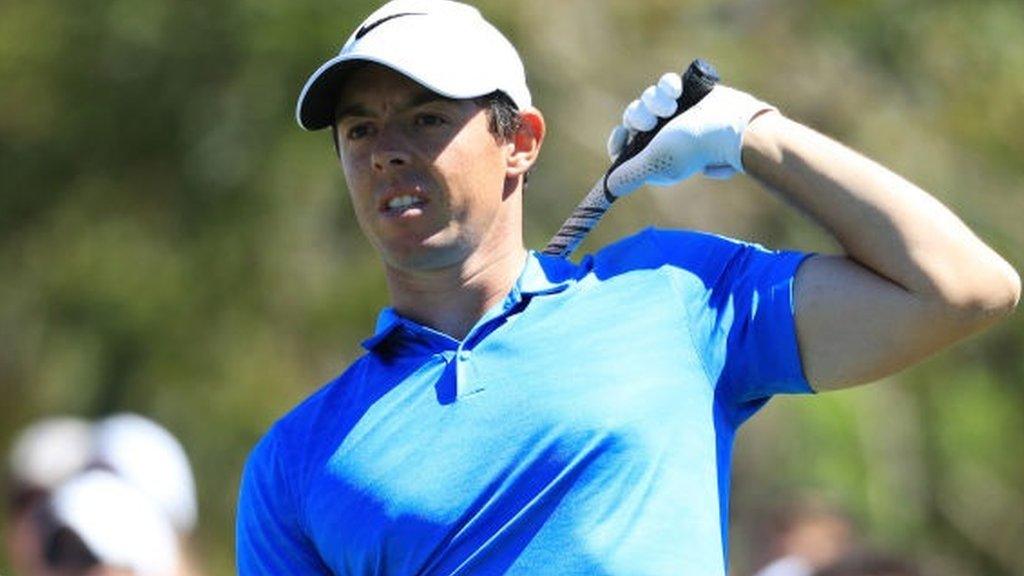US Open 2017: 'Panicky' USGA needs to impress at Erin Hills
- Published

Erin Hills golf course will host the first US Open in Wisconsin
The United States Golf Association (USGA) is a governing body under intense scrutiny as it prepares to stage next week's US Open at Erin Hills.
There is a growing feeling that players are losing patience with the ways of the USGA.
And after damaging controversies at the last two US Opens, former world number one Adam Scott described them as "panicky" and followed Phil Mickelson in piling pressure on the beleaguered organisation.
Two years ago at Chambers Bay, the USGA seemed the only observers unwilling to criticise greens so bumpy they were not fit to stage a monthly medal, never mind one of the big four majors.
"They were simply the worst most disgraceful surfaces I have ever seen on any tour," Ian Poulter said at the time.
Then came last year's ham-fisted handling of the Dustin Johnson rules fiasco that left no one knowing the leader's score throughout most of the final round at Oakmont. It was a farce that, again, portrayed the sport in a poor light.

Adam Scott wants the USGA to refrain from delivering a difficult golf course at next week's US Open
Thankfully Johnson's contentious one stroke penalty, after he was deemed to have caused his ball to move on the fifth green, did not affect the eventual outcome as the current world number one brilliantly closed out his first major title.
Asked by American magazine Golfweek if he thought the USGA were feeling the heat, Scott replied: "Absolutely."
"They've taken criticism for the last two years, I'm sure they're not liking it. They're going to have to try to run a really good event."
This week the USGA have the opportunity to make their final tweaks to the par-72 Wisconsin course, which is just eleven years old and stages its first US Open, starting on 15 June.
It is another gamble to hold the championship on such a young course especially so soon after Chambers Bay, a course that opened for business in only 2007.
Famed for being the toughest of the majors, ahead of the Masters, Open and PGA Championship, the US Open is usually set up to make level-par a winning score.
Narrow fairways, uncompromising rough, rock hard lightning fast greens and relentless length are the stocks in trade of America's national championship.
It can make for attritional, one-dimensional golf where the last man standing claims the title.
"The ball is in their court; they control it all," Scott added. "Hopefully they get it right this time, just from a playability standpoint.
"Let's just have something that's a challenge and interesting, not just playing brutal."
The 36-year-old is one of the game's deeper thinkers. "Maybe it's time to do away with the even-par target, just thinking about the bigger picture of the game of golf," said the 2013 Masters champion.
"If their major pinnacle event requires courses to be the way they are, it doesn't set a good example for every other bit of golf that they try to promote. Maybe we should get the numbers out of our heads and try a new strategy."
It seems the USGA recognise they are under pressure. Their chief executive Mike Davis recently met with the PGA Tour's player advisory council in a bid to improve relations.

The USGA were criticised for acting too quickly in applying a two-stroke penalty to Anna Nordqvist's score in the 2016 US Women's Open play-off
"Whether it's rules changes or any other decisions they make, I think their process is out," Scott said of the administration which jointly sets golf's rules with the R and A.
"I just don't see how they get to some of these decisions. They're hanging onto the rules of golf by a thread, really. That's why they're panicky and they're trying to see what's going on out here on Tour."
The USGA was also criticised at last year's Women's US Open for their handling of a penalty imposed on Anna Nordqvist for touching the sand in a bunker during her three hole play-off with eventual champion Brittany Lang.
On the final hole, rules officials were out of sequence when they informed the players of the Swede's two-stroke penalty which was incurred on the previous hole and only detected by a high definition television camera.
Oblivious to her rules infraction Nordqvist hit her third shot to the last green - then Lang, who was in full possession of the facts, could play a more conservative approach to the final play-off hole to close out victory.
To cap it all USGA president Diana Murphy erroneously referred to champion Lang as "Bethany" at the presentation ceremony.
Rightly or wrongly, they can expect further criticism for staging this year's Women's US Open at Donald Trump's Bedminster course in New Jersey.
Mickelson was withering in his assessment of the USGA at last month's Players Championship. The six times runner up was asked whether a successful men's US Open at Erin Hills would restore the USGA's reputation.
"I don't know if doing one thing right is going to fix that," replied the left hander, who is set to miss next week's championship to attend his daughter's high school graduation.
Only a delay to first round proceedings through adverse weather would create the time for Mickelson to complete his parental duties and tee it up at the year's second major.
The 46-year-old, who has won the three other majors, will probably be nothing more than an interested but distant spectator for this US Open.
And like most of the golfing world he will want to see whether the USGA can put on a blemish-free tournament.
Their stated aim of a US Open is to thoroughly test each and every part of a player's golf game. Next week all aspects of their organisational competence face an even sterner examination.
- Published4 June 2017

- Published3 June 2017

- Published5 June 2017
